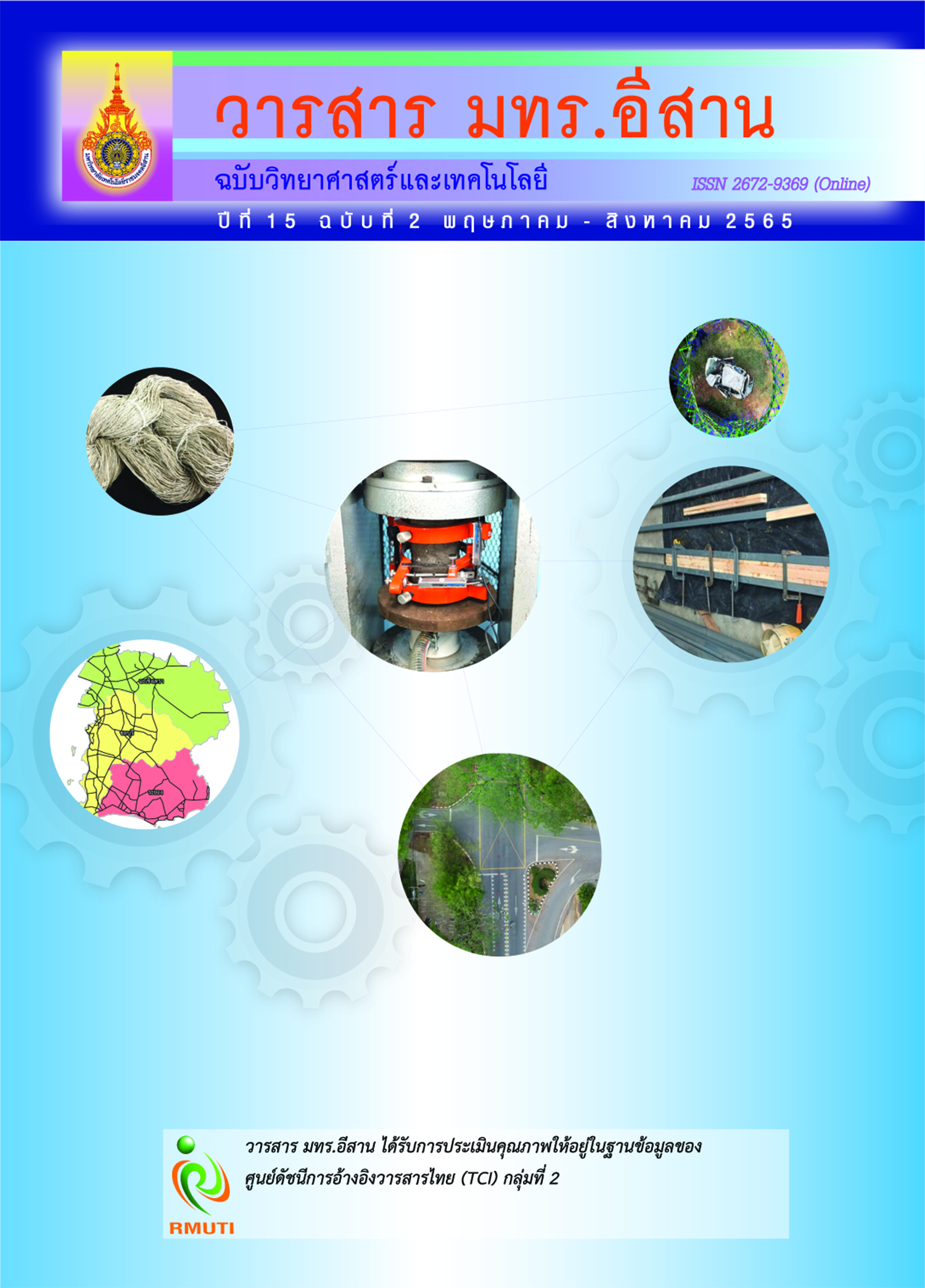การศึกษาขนาดที่เหมาะสมของระบบผลิตนํ้าร้อนจากปั๊มความร้อนเสริม ด้วยการผลิตไฟฟ้าและน้ำร้อนพลังงานแสงอาทิตย์: กรณีศึกษาโรงแรมไก่นคร นครหลวงเวียงจันทน์ ประเทศลาว
Main Article Content
บทคัดย่อ
โรงแรมไก่นคร ประเทศลาว มีการใช้น้ำร้อน 2,000 ลิตรต่อวันที่อุณหภูมิประมาณ 60 - 65 oC โดยใช้ขดลวดไฟฟ้าขนาด 20 กิโลวัตต์ ใช้พลังงานไฟฟ้า 95.54 กิโลวัตต์ชั่วโมงต่อวัน ซึ่งสิ้นเปลืองพลังงานไฟฟ้าเป็นจำนวนมาก ดังนั้นงานวิจัยนี้จึงทำการศึกษาขนาดระบบผลิตน้ำร้อนจากปั๊มความร้อนเสริมด้วยการผลิตไฟฟ้าและน้ำร้อนพลังงานแสงอาทิตย์ (Solar PV/T Boosted Heat Pump) ที่เหมาะสมกับการใช้น้ำร้อนในโรงแรมไก่นคร โดยงานส่วนแรกทำการศึกษาและทดสอบสมรรถนะทางด้านไฟฟ้าและความร้อนของแผงผลิตไฟฟ้าและน้ำร้อนพลังงานแสงอาทิตย์ (Solar PV/T) ขนาด 330 วัตต์ ตามมาตรฐานการทดสอบเพื่อสร้างสมการทำนายสมรรถนะของแผง จากการศึกษาพบว่า สมรรถนะทางความร้อนของแผง Solar PV/T มีค่า FR(τα)e และค่า FRUL เท่ากับ 0.4018 และ 10.466 วัตต์ต่อตารางเมตร•องศาเซลเซียส ประสิทธิภาพการผลิตไฟฟ้าของแผง Solar PV/T มีค่าเฉลี่ยเท่ากับ 16 % และได้สมการทำนายสมรรถนะของระบบ Solar PV/T Boosted Heat Pump การศึกษาส่วนที่สองจะใช้สมการที่ได้ จากส่วนที่ 1 มาทำแบบจำลองทางคณิตศาสตร์เพื่อออกแบบระบบและวิเคราะห์ความคุ้มค่าทางด้านเศรษฐศาสตร์เพื่อเลือกขนาดที่เหมาะสมของระบบเพื่อทดแทนการใช้ระบบเดิมที่มีการใช้ขดลวดไฟฟ้าขนาด 20 กิโลวัตต์ ผลิตน้ำร้อนอุณหภูมิ 60 - 65 oC จำนวน 2,000 ลิตรต่อวัน จากการศึกษาพบว่า ระบบทำน้ำร้อนที่ใช้แผง Solar PV/T ขนาด 330 วัตต์ จำนวน 12 แผง ร่วมกับปั๊มความร้อนขนาด 17.8 กิโลวัตต์ เหมาะสมที่สุด การใช้พลังงานไฟฟ้าจากระบบไฟฟ้าพื้นฐานลดลง 28,072.71 กิโลวัตต์ชั่วโมงต่อปี หรือคิดเป็นค่าไฟฟ้าที่ประหยัดได้เมื่อเปรียบเทียบกับการใช้งานขดลวดไฟฟ้าเท่ากับ 84,779.58 บาทต่อปี ใช้เงินลงทุน 604,180 บาท และมีระยะเวลาคืนทุนเท่ากับ 7.13 ปี
Article Details

อนุญาตภายใต้เงื่อนไข Creative Commons Attribution-NonCommercial-NoDerivatives 4.0 International License.
เอกสารอ้างอิง
Sonsaree, S., Asaoka, T., Jiajitsawat, S., Aguiree, H., and Tanaka, K. (2017). VCHP-ORC Power Generation from Low-Grade Industrial Waste Heat Combined with Solar Water Heating System: Power Generation and CO2 Emission in Industrial Estate of Thailand. Cogent Engineering. Vol. 4, Issue 1, p. 1359397. DOI: 10.1080/23311916.2017.1359397
Suwanasang, N. and Tongsopit, S. (2015). An Assessment of the Technical and Economic Potential of Rooftop Solar Systems on Chulalongkorn University’s Buildings. Journal of Energy Research. Vol. 12, No. 2, pp. 59-74. (in Thai)
Ministry of Energy (2009). Technology of Using Heat Pumps for Heating. Bangkok: In-depth Technology Demonstration Project for Energy Conservation. Department of Alternative Energy Development and Efficiency. (in Thai)
Sun, X., Dai, Y., Novakovic, V., Wu, J., and Wang, R. (2015). Performance Comparison of Direct Expansion Solar-Assisted Heat Pump and Conventional Air Source Heat Pump for Domestic Hot Water. Energy Procedia. Vol. 70, pp. 394-401. DOI: 10.1016/j.egypro.2015.02.140
Herrando, M., Ramos, A., Zabalza, L., and Markides, C. N. (2019). A Comprehensive Assessment of Alternative Absorber-Exchanger Designs for Hybrid PV/T-Water Collectors. Appilied Energy. Vol. 235, pp. 1583-1602. DOI: 10.1016/j.apenergy.2018.11.024
Huide, F., Xuxin, Z., Lei, M., Tao, Z., Qixing, W., and Hongyuan, S. (2017). A Comparative Study on Three Types of Solar Utilization Technologies for Buildings: Photovoltaic, Solar Thermal and Hybrid Photovoltaic/Thermal Systems. Energy Conversion and Management. Vol. 140, pp. 1-13. DOI: 10.1016/j.enconman.2017.02.059
Chanthaseng, S. and Mongkon, S. (2021). Experimental Performance of Hot Water Production by Solar PV/T Boosted Heat Pump System for Electricpower Costs Reduction in a Slaughterhouse. Engineering Journal Chiang Mai University. Vol. 28, No. 1,
pp. 110-126. (in Thai)
Wanchupela, N. and Polvongsri, S. (2021). Size and Type Optimization of Solar Photovoltaic Thermal Hybrid Assisted Heat Pump in Slaughterhouse. Engineering Journal Chiang Mai University. Vol. 28, No. 1, pp. 127-140. (in Thai)
Chanthaboune, V. and Kiatsiriroat, T. (2007). Performance Testing of a Solar Assisted Heat Pump Water by using an Unglazed Flat-plate Solar Collector as an Evaporator. In Conference on Thermal Energy and Mass Transfer in Thermal Devices. Chiang Mai
University, Chiang Mai Province. 15-16 Mar, Amora Chiang Mai, 2550. (in Thai)
Chaichana, C., Kiatsiriroat, T., and Nuntaphan, A. (2010). Comparison of Conventional Flat-Plate Solar Collector and Solar Boosted Heat Pump Using Unglazed Collector for Hot Water Production in Small Slaughterhouse. Heat Transfer Engineering. Vol. 31, Issue 5, pp. 419-429. DOI: 10.1080/01457630903375475
Jie, J., Keliang, L., Tin-tai, C., Gang, P., Wei, H., and Hanfeng, H. (2008). Performance Analysis of a Photovoltaic Heat Pump. Applied Energy. Vol. 85, Issue 8, pp. 680-693. DOI: 10.1016/j.apenergy.2008.01.003
Saysana Chanthaseng. (2021). Energy Cost Reduction of Slaughterhouse with Hot Water Generation from Solar Photovoltaic Thermal Hybrid Booted Heat Pump. Thesis, Master of Engineering in Renewable Energy Engineering, School of Renewable
Energy, Maejo University. (in Thai)
NASA POWER Data Access Viewer. (2020). Solar Radiation and Ambient Temperature. Access (17 May 2021). Available (https://power.larc.nasa.gov/data-access-viewer/?fbclid=IwAR21o8oBtosEgetYzfm0HfWGFM3G6XfJ_t1nFLLBFNv-ito6j6mN_iYavkk).
Anderson, T. N., Morrison, G. L., and Behnia, M. (2003). An Experimental Evaluation of an Air Source and a Solar Boosted Heat Pump Water Heater. Destination Renewables - ANZSES


